The mitzvah of tefillin is an enigma among human rituals: Tefillin are black leather boxes containing parchment scrolls inscribed in meticulous accordance with the criteria of an ageless scribal art. Not to be read, but to be worn.
Yet from Sinai to Jerusalem, Babylon to Masada, Auschwitz to Manhattan, through fire, sword, forced labor and affluence—we carried tefillin to this day, guarding the chain of transmission with our very lives.
Wrapping tefillin very much feels like you are tieing yourself to every other Jew and to the G‑d of Israel in a tight bond. It's also one of those mitzvahs that's meant to remind us of our liberation from Egypt, when we became untied from bondage to human beings by becoming tightly bonded to the Master of the Universe.
Tefillin is said to have a real effect on the people that wrap in the every morning. Their mind and heart are connected together in a perfect bond with the infinite light of the Creator.
Here is one explanation of how that works:
Hi-Tech Connectivity
This was back in the early sixties, when the first mainframe computers were being introduced into business. Professor Abraham Polichenco, a pioneer of computer technology, visited the Lubavitcher Rebbe and posed to him a question:
“I know that everything that exists in the world, even something that we discover later in history, has its source somewhere in the Torah. So, where are computers in the Torah?”
Without hesitation, the Rebbe answered, “Tefillin.” The professor was perplexed.
“What’s new about a computer?” the Rebbe continued.
“You walk into a room and you see many familiar machines: a typewriter, a large tape recorder, a television set, a hole puncher, a calculator. What is new?
“But under the floor, cables connect all these machines so they work as one.”
The professor nodded enthusiastically. He hadn’t realized it before, but yes, this is all that a computer is: a synthesis of media and processing devices.
“Now look at your own self. You have a brain. It is in one world. Your heart is in another. And your hands often end up involved in something completely foreign to both of them. Three diverse machines.
“So you put on tefillin. First thing in the day, you connect your head, your heart and your hand with these leather cables—all to work as one, with one intent. And then, when you go out to meet the world, all your actions find harmony in a single coordinated purpose.”
What’s in the Tefillin?
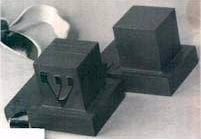
The boxes: Head-tefillin (left) and arm-tefillin (right).
|

Inside view: In the head-tefillin ( L ) the four Torah portions are inscribed on four strips of parchment and placed in four compartments. A single scroll contains all four portions in the arm-tefillin ( R ).
|

The straps: The head-tefillin (top) has a loop the size of the wearer's head, tied with a knot the shape of a daled. The hand tefillin has an adjustable loop for fastening on the arm, and a yud-shaped knot.
|
There are many laws and requirements regarding the making of tefillin, and it takes many years of training to qualify the scribes and craftsmen who make them. What follows is a basic description.
A set includes two tefillin—one for the head and one for the arm. Each consists of three main components: the scrolls, the box and the strap.
The scrolls are strips of parchment upon which are inscribed four passages from the Torah: Kadesh (Exodus 13:1–10), VeHayah Ki Yeviacha (Exodus 13:11–16), Shema (Deuteronomy 6:4–9) and VeHayah Im Shamoa (Deuteronomy 11:13–21). In the arm-tefillin, the four passages are written on a single scroll; in the head-tefillin, they’re on four separate scrolls.
The scrolls are inserted into boxes made of leather that has been painstakingly pressed into the tefillin’s perfectly smooth planes and precise geometrical shape, and painted black. The upper part of the tefillin box is a perfect cube; the lower part is a flatter box that is wider than the upper part. On one side, the lower part extends further than the other sides, and has a slit through which the tefillin strap is threaded. The head-tefillin has four compartments, for the four scrolls, and has a raised Hebrew letter shin on each side.
The straps are made of leather painted black on one side. They are threaded through the lower part of the boxes and knotted. The head-strap’s knot is in the shape of the Hebrew letter daled; the hand-tefillin is knotted in the shape of the Hebrew
letter yud. (Together, shin, daled, yud spell Sha-da-i—one of the names of G‑d.)
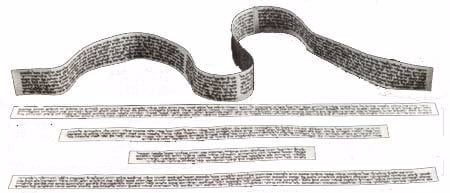
The Kabbalah of Tefillin
Kabbalah is an esoteric wisdom that explains the secrets of the cosmos and the things Jewish people do. Like tefillin.

According to Kabbalah, the world is projected into being by an infinite light focused through ten harmonious sefirot. But at the time of creation, only seven of the sefirot descended within seven days and generated our world. The first three, those of Mind, stayed up there, sort of out of the picture.
That’s why, to this day, people’s bodies are generally not in sync with their minds. Neither are their hearts or their actions. Actually, nothing’s much in sync with anything. It all goes back to that first Big Bang of light.
Tefillin is all about healing that rift. You do your part, connecting your mind and heart with these leather straps and black boxes with scrolls inside—and the effect reverberates throughout the cosmos. Heaven connects to earth, spiritual to physical, Creator to creation. Everything starts getting into harmony with its essence and inner purpose.
Tefillin Reborn
In June 1967, the Jewish nation was once again in dire danger. The neighboring Arab states, led by Egypt and with Soviet support, were tightening the noose, threatening to utterly annihilate the fledgling state of Israel. Pundits predicted they would have an easy victory. The Israeli government feared another holocaust on the horizon.
One Jewish leader stood up with confidence and strength. Rabbi Menachem M. Schneerson, the Lubavitcher Rebbe, spoke publicly and ensured that his message would be transmitted to Israel: G‑d would make great miracles for His people and protect them. In the merit of tefillin, the enemy would turn in fear and flee.

Tefillin observance at the time was at an all-time low. Rituals had fallen out of fashion with the climate of conformity that pervaded the Cold War era. But now began an urgent campaign for Jews everywhere to wrap tefillin. Businessmen rolled up their sleeves on the street, as did students on campus, and, of course, soldiers in the Israeli army.
The rest is history: The enemy quickly scattered in retreat and surrendered to a ceasefire after only six days of battle. Jewish pride took off like a rocket, and a renaissance of Torah Judaism ensued in Israel, in the West and even in Russia.
Today, Jews of all walks of life can be found wrapping tefillin every morning—some for an entire hour of prayers, some for only the five minutes it takes to put them on, say the Shema and take them off again. After all, that five minutes may be just what it takes to make a whole new world.
So How Do I Do This?
At Chabad.org, you’ve got multiple routes to learn how to wrap that black leather.
Here’s an illustrated tutorial to get you through the process: Putting on Tefillin
Here’s one with 3D animation: Jay’s Tefillin Wizard
Here’s a video tutorial, narrated by Rabbi Jonathan Sacks: How to Put On Tefillin
And here’s a short video that gives you the whole thing in one shot:
But, just in case none of those work for you, here’s:
How to Wrap Tefillin in Seven Easy Steps:
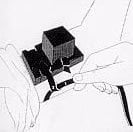
1) You have two black leather boxes with straps in your tefillin bag. One is for the arm, the other for the head. Get out the arm one (that’s the one that’s one smooth box, rather than four compartments). The arm-tefillin goes on the weaker arm: right-handed people do the left arm, lefties do the right arm.
2) Roll up your sleeve so that the tefillin is in direct contact with your arm. Put your arm through the loop formed by the knotted strap. Place the black box up on your biceps, right across from your heart, with the strap part closest to your shoulder.

3) Recite the blessing. If you can read and understand the original Hebrew, say it in Hebrew. Otherwise, you can say it in any language you understand.
Here’s the Hebrew text:

Here’s how it sounds:
Baruch atah Ado-nai, Elo-heinu melech ha’olam, asher kideshanu b’mitzvotav, v’tzivanu l’haniach tefillin.
Here’s what it means:
Blessed are You, L‑rd our G‑d, King of the universe, who has sanctified us with His commandments, and commanded us to put on tefillin.
Focus on what you’re doing. From the time you make the blessing until both tefillin are in place, do not talk. Don’t even wink to anybody. Just concentrate on hooking up your mind, heart and deeds, and binding them to G‑d.


4) Tighten the strap around your arm, mindful that the knot stays in direct contact with the box. Continue to wrap: two more times over the strap-socket of the black box and around the biceps, then seven times around your arm and once around your palm. Leave the remainder of the strap loose.
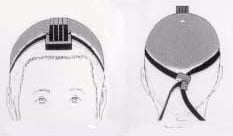
5) Next, get out the head-tefillin. The box goes on your head, just above your forehead. Center it in the middle of your head, directly above the point that’s right between your eyes. The daled-shaped knot should rest on the base of your skull.
6) Now back to your hand.
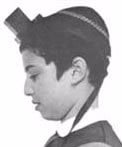
Wrap the remainder of the strap three times around your middle finger, like this: once around the base, then once just above the first joint, then one more time around the base. You’ve got some strap left over, so wrap it around your palm and tuck in the tail end.
7) Recite the Shema Yisrael.
Hebrew text:

This what it means (say this if you don’t read Hebrew):
Hear, O Israel, the L‑rd is our G‑d, the L‑rd is One.
Blessed be the name of the glory of His kingdom forever and ever.
You shall love the L‑rd your G‑d with all your heart, with all your soul and with all your might. These words which I command you today shall be on your heart. You shall teach them thoroughly to your children, and you shall speak of them when you sit in your house and when you walk on the road, when you lie down and when you rise up. You shall bind them as a sign upon your arm, and they shall be for a reminder between your eyes. You shall write them upon the doorposts of your house and upon your gates.
FAQ
Q: Who does this?
A: Every Jewish male, from the age of bar mitzvah (13) and up.
Q: When am I supposed to do it?
A: Every day except Shabbat and Yom Tov. (Preferably in the morning; but you can do it all day, until nightfall.)
Q: Where do I get tefillin?
A: Your local Chabad rabbi will be glad to help you get the real thing at a reasonable cost.

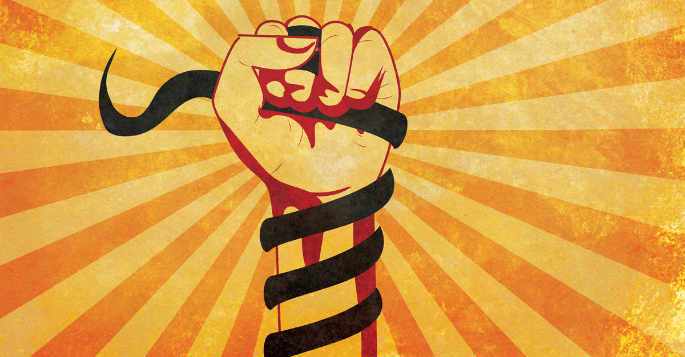






Join the Discussion